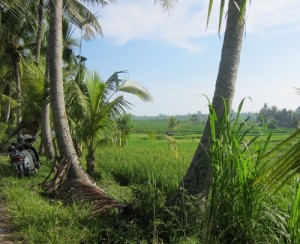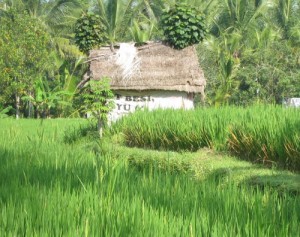The Starbucks in Ubud, Bali has to be one of the nicest on the planet. Set at the corner of a centuries-old Hindu temple property, the building has more the appearance of upscale art gallery than coffee shop. Its interior walls and floors are marbelled, thick comfortable chairs dampening the echoes. Its patio overlooks an ancient water garden, its lotus leaves occasionally disturbed by the invisible movements of gargantuan carp beneath the surface. In Ubud, global commerce has attached itself firmly to the spiritual world. But we’re looking for a little more… or maybe a little less. To get away from the manufactured Ubud, the movie town, to what was here before. We are going to see the rice fields.
We turn off the main road, and walk up a side street that seems to have been a communitytourism project at one time; visitors to  Ubud have left their names engraved on squares of concrete. Little messages into the future from around the world. Reading them helps pass the time as we walk past the homestays, villas and corner stores that trickle away into simpler structures.
Ubud have left their names engraved on squares of concrete. Little messages into the future from around the world. Reading them helps pass the time as we walk past the homestays, villas and corner stores that trickle away into simpler structures.
 Ubud have left their names engraved on squares of concrete. Little messages into the future from around the world. Reading them helps pass the time as we walk past the homestays, villas and corner stores that trickle away into simpler structures.
Ubud have left their names engraved on squares of concrete. Little messages into the future from around the world. Reading them helps pass the time as we walk past the homestays, villas and corner stores that trickle away into simpler structures.Another hundred metres and we reach the edge of town, emerging into a vista simply out of time. Stretching out before us are fields of rice. We can see for at least a kilometre, before low rolling hills and stands of trees block the view. Terraces of uniform green, knee-high stalks of the food that feeds more than half the planet.
The pathway continues between the fields. It’s trimmed by a deep groove in the earth where water flows. The irrigation system, powered by gravity, provides a trickle of water, just enough, to millions of plants over thousands of hectares of land.
The fields remind me of a golf course, in their uniformity and precision. After centuries of use, every plot of land is trimmed, tended and defined. Low-lying groundcover plants edge the fields.
There are no weeds to be seen; the lip of one terrace drops, black earth and vertical, onto the next.
The water paths are deep and edged in rock; the fall of water is measured in centimetres over football-field lengths. The paths twist and turn on occasion, as they branch off to field fields in the distance. Nothing is wasted.
The path has carried us into a different time, a different cycle of life. The pace here is the seeding of the rice, of the flooding of the fields, the weeding, of harvest and feasts. Its rhythm is the waxing and waning of the moon, the steady demands of the gods. It’s the birth of children, the application of life’s energy for decades to growing things, the final spreading of an elder’s ashes. Its soundtrack is the wind blowing over the fields, growing louder as the sun pulls the stalks up to fruit.
The cement path turns to dirt and we enter a stand of trees. We are moving upstream, against the flow of the channelled water. We pass small control structures, not much more than cement gates a half-metre high. Here some ducks are splashing in a small pond caused by a fallen palm leaf blocking the water’s path; there a yellow-headed lizard flits into invisibility in the underbrush.
It’s cool under the canopy, a refuge from the equatorial sun.
We’re just on the edge of town, but far away in time. There’s nothing that couldn’t have been here a century ago. Each corner of each field has a small temple or spirit house; incense curls from the box where the gods take their percentage of human attention. Scarecrows chase birds away, and bring the only incongruity to the ancientness of the scene- they wear old gortex sportwear, and promote a local football club. But the anachronism is easy to ignore.
We ascend from the treed gully into more open fields, and are greeted by a man along the path. “Water?” he asks, pointing a few yards away. He’s set up a small kiosk, selling snack foods and soft drinks from a glorified lemonade stand. We buy a couple of bottles of water from him. “Sit, please,” he says, pointing to a rickety old picnic table next to the stand. “It’s nice there. Very hot this morning.” We decline awkwardly. We tell him we have to get back to our kids, sleeping back at the hotel.
It’s only partly true- sure, they are there. But they’d be fine without us for a while yet. I wonder why. It’s more like we want to avoid the contact, we don’t feel part of this time, his time. The life-pace here makes us anxious somehow, we haven’t learned to relax yet. We say our goodbyes and continue down the path.
There are more reminders that people follow a different drum here. A woman bathing in the stream, covering herself as we pass. A browned elder washes some roots for his lunch. A woman in fine dress carries offerings and carefully refreshes a field’s spirit houses.
We approach an ancient temple, with chest-high walls and low-lying altars inside. A group of farmers are chanting low hymns. A woman regards us cooly as we walk by, and resumes her singing. We move away in silence. We are not of her time.
We’ve turned around now, and just as the trappings of modern life slowly disappeared as we entered the fields, they begin to return. The path changes back to cement. Small buildings, selling local art or housing families, dot the land. Motorcycles twist and turn up the path, forcing us off with an apologetic smile from the driver. The world becomes noiser. The pace becomes faster as the cement turns to asphalt. We pass by a construction site, machines screaming as they cut wood and ceramic.
We’re back on the main road. We’ve returned to our time, our pace. We head into the Starbucks.

John Boivin is new to the blogosphere but not to writing. He worked as a print, radio and web journalist for more than 25 years until his retirement in 2010. He is now indulging in an old passion, landscape painting, as well as a new one, travel. He lives in Whitehorse, Yukon, Canada with his family.









